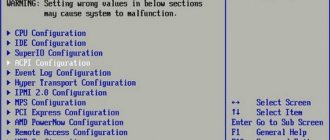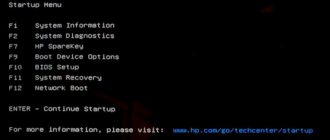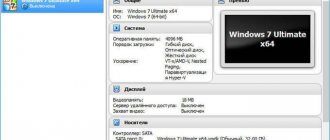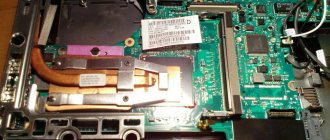The Windows 8 (8.1) operating system has several high-quality recovery and reset mechanisms. You can reset the system fully, clearing all user data, as well as performing recovery, leaving the data, you can also roll back the OS to the state on specific point in time.
If your Windows is installed in such a way that it has a recovery partition, then you will not need any additional disks to return to the original settings. This happens when you buy a PC with a pre-installed system.
If you installed Windows yourself from a distribution kit , then most likely you will need it when performing a return to the original state.
If the preinstalled system was Windows 8, and then it was updated to 8.1, then after the reset you will need to install updates for this version again.
Starting recovery
All recovery and reset methods are available from one section of the Windows 8 OS settings, so we’ll tell you how to “get to” it.
In desktop mode, swipe your mouse along the right edge of the screen from bottom to top or top to bottom. As a result of this action, a menu will appear; in it, click on the “ Options ” item. Next, in the menu that appears again, click on “ Change computer settings ”. And now “ Update and Recovery ”.
Next, click “
Recovery ”.
We are there: we are offered a choice of 3 reset / recovery modes.
Recovering your computer without deleting files
In this mode, only the operating system system data will be updated, that is, it will be reset to its original state. All your user data will remain intact: music, videos, photos and other data.
However, you will need to reinstall apps and all updates, including upgrading to Windows 8.1
Removing all data and reinstalling Windows
After performing such a reset, the computer will be completely cleared of any user information. The OS will be completely reset to its original factory settings. All your data will be permanently deleted from your hard drive. It will also reset any settings you made on your PC. The manufacturer recommends performing such a reset if you give away or sell your computer.
Special download options
Use this method if you have previously created an image (recovery disk) of the operating system. If you haven't done this, of course, this point won't be useful to you.
How to reset Windows 8 to factory settings
During the operation of any operating system, including Microsoft's Eight, the user usually makes quite a lot of individual changes to its workflow. Which can sometimes lead to negative results: failures, slowdowns, and so on. The way out of this situation will be to answer the question - how to reset Windows 8 to factory settings? That is, actually get the original version of the operating system without reinstalling it.
Restoring Windows 8 to factory settings is indeed possible - the developers have provided for such actions on the part of the user. The only thing that is required is to teach how to properly restore factory settings.
The first option to return Windows 8 to factory settings
In order to return Windows 8 to factory settings, it is not at all necessary to download any additional programs or have certain programming skills - just use the functionality that is already in the operating system itself:
- Activate the panel hidden on the right side of the desktop screen;
- Go to: “Settings” – “Changing settings” – “Update and recovery”.
A list of options will appear, of which the first two allow you to return the computer to its original state:
- Restore without deleting. Resets Windows 8 while retaining all of the user's files and items;
- Removal and reinstallation. In fact, it allows you to achieve the same result, but all information from the system partition of the hard drive will disappear. Therefore, if the user decides to choose this method to reset his OS, it is initially recommended to take care of saving important personal data in another place.
The second option is to restore the system
Another way to roll back the system is to use special restore points. Its problem is considered to be the forgetfulness of people, who often simply forget to create such beacons that can help cope with most of the troubles that arise.
If such a possibility still exists, then the user needs to do the following:
- In the control panel, select "Recovery".
- Next, go to settings, which will open the “OS Properties” window with the “OS Protection” tab available.
- In the tab itself, you need to select the topmost option by clicking on the corresponding button.
- A list of available points will appear. If one of them was created immediately after the installation of the Eight was completed, then there is a real chance to return the factory settings to Windows 8.
Third alternative
Another way to achieve the desired result is to create a new account, the appearance of which forces your OS to make initially available settings for such a profile.
To do this, you need to repeat the following procedure:
- Press “Win” and “I” at the same time;
- Go to “parameters” – “change” – “parameters”. PC" - "Accounts" - "others" - "adding".
In the new window, it is important to select the option to sign in without a Microsoft account. Then everything is simple - specify the user name and personal password. All that remains is to restart the computer in order to be able to almost fully use the functionality of the OS in its original state.
windows-azbuka.ru
Creating a recovery disk
For the case of a pre-installed OS, when you do not have a Windows distribution, such a disk may be needed if the computer does not boot . Therefore, we strongly recommend that you create and store it, especially since a regular flash drive with a capacity of no more than 8 GB is suitable for this.
This is especially true if you upgraded to 8.1. Installing an update is a very time-consuming process, and careful creation of a disk with an OS image will save a lot of time in the future.
Here is one way to create such a disk.
Right-click on the bottom left corner of the screen ( Start ) and select Control Panel .
In the upper right corner of the control panel, write “recovery” in whole or part of the word in the search box and press the Enter button. Select the desired item from the search results.
Begin the disc creation process.
How to reset Windows 8 to factory settings
Windows 8 provides a procedure for returning to initial settings, including saving user files. This method is best used if a normal rollback to one of the restore points did not work. The main condition for returning to the initial parameters in the described way is that the system must be able to start, otherwise other options will have to be used.
Restoring factory settings without deleting user data
To roll back Windows 8, you must follow these steps:
- Open Charms (the panel that slides out when you hover the mouse on the right), in the “Settings” section, select the option to change computer settings.
- A list of actions will open, from which you should select “Update and Recovery”, then “Recovery”.
- Next, all that remains is to run the command to restore the system without deleting files, after which the computer will perform all the actions on its own.
It is important to understand here that user data in this case means only photos, documents, videos, music, etc. recorded on the disk, but not installed applications in any way - they will no longer be able to work after returning the factory settings (with the exception of standard and installed from the Store - they will be reinstalled again).
Rollback with deletion of user data
In the same “Recovery” section there is a command that suggests deleting all data and reinstalling the system. You can use it if for some reason the first method did not help solve the problem by restoring the factory settings.
But even in this case, downloads and personal data can be left untouched if the disk is partitioned and, accordingly, user files are not stored on the system partition, which will be completely cleared.
Things to consider before resetting settings
The system recovery described above is completely valid for PCs and laptops purchased with Windows 8 pre-installed. These systems initially have a hidden recovery partition. There are some nuances associated with this:
- If you installed the OS after purchasing the device, you will need a disk or flash drive with the system distribution, from which the files necessary for the recovery procedure will be loaded.
- If after purchasing the device you updated the system to version 8.1, then after the procedure you will receive the old eighth version of the OS.
- The following steps may require you to enter your product key.
Next, we will tell you how you can return Windows 8 settings to factory settings, even if the system cannot be started.
Let's use the hidden section
If the OS was originally installed on a laptop or computer, then there is a very simple way to restore the system. The only condition is an undamaged hard drive.
Each brand and model of device with the “eight”, when you press a certain key combination, automatically returns it to its original settings without saving personal data. The only difficulty is that this combination changes from model to model, so for each specific case you have to look for information in the specification for the device or on the Internet.
We create a hidden Recovery partition ourselves
Using a hidden partition to restore the system is very convenient, so for systems created “on the knee”, you can suggest using the Aomei OneKey Recovery program, which creates this partition on the disk and, accordingly, allows you to quickly reset Windows 8 to its original state.
Let’s immediately make a reservation that it is better to use the above-mentioned program immediately after a “clean” installation of the system and drivers, as long as there is nothing superfluous in it.
Before running Aomei OneKey Recovery for the hidden partition, you will need to allocate an unallocated area on the disk:
- press Win+R, write diskmgmt.msc in the command field of the Run window;
- Right-click on the last volume of disk 0 and select the “Shrink volume” command;
- specify the value by which the volume needs to be compressed, equal to the amount of space occupied on the C (system) drive.
After this, you can run the free Aomei OneKey Recovery program. In the main application window, you need to select the first item OneKey System Recovery (create a recovery partition).
Next, a window will open to select a medium for saving the image. It can be an optical disk or a flash drive, but we are interested in the very first partition - the hard drive. After selecting it, the program will show the structure of the disk and the method in which the partition will be created. All you have to do is agree, after which the program will create a grayish partition for quick recovery of Windows 8.
Report content
recoverit.ru
Advice
Use the mechanism for creating restore points. Use it before installing suspicious software, as well as before performing any complex operations with OS settings. This way you can easily return to a working state without resorting to a full system reset.
Make sure that automatic creation of these points is turned on. To do this, right-click in the lower left corner of the screen and select “ System ”.
Next, click " System Protection ".
Then: Configure for each specific drive.
And in the window that opens, select “ Enable protection system ”. Here you can also set the disk space that will be used by this function.
Now you can return to the state of the system that was at the time the point was created, that is, perform a partial rollback of the system in the event of a failure.











